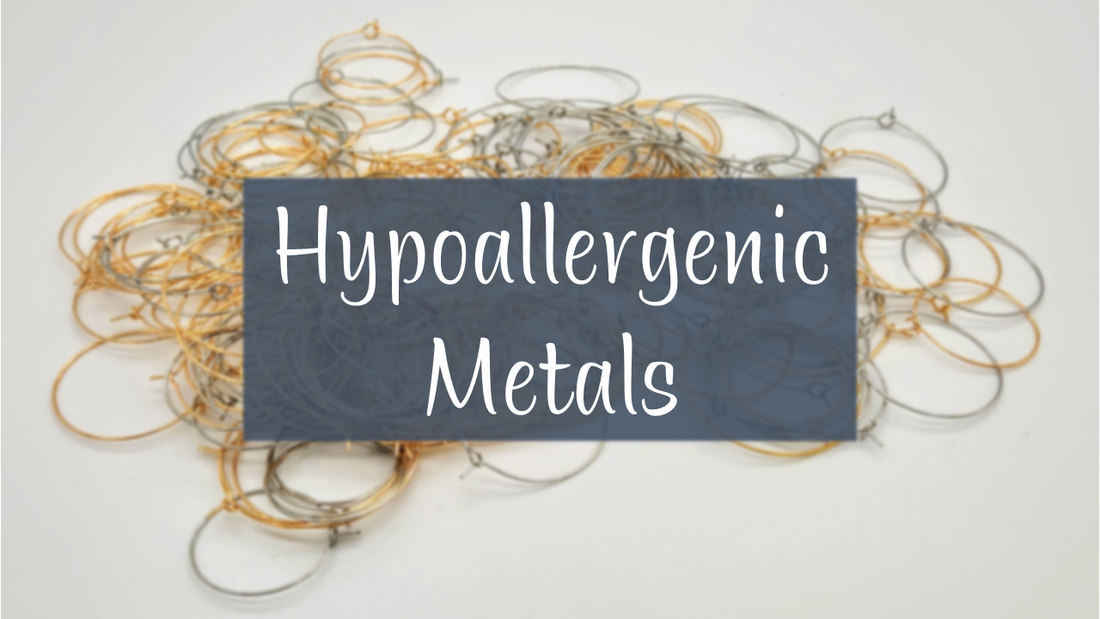
What is Hypoallergenic Jewlery?
What does hypoallergenic mean? Which jewelry metals are hypoallergenic? Are they safe for everyone to wear? Which metals cause allergies? Is surgical stainless steel any better than other grades? Where can I buy hypoallergenic earring findings?
Let’s define hypoallergenic: The term typically means the metal is less likely to cause an allergic reaction in most people, but this does not guarantee it will be safe for everyone.
People can react to several types of metals, with nickel being the most common allergen. About 15 percent of people globally, and up to 20 percent in some regions, are estimated to have a nickel allergy. Sensitivity varies widely. Some individuals can tolerate metals with low nickel concentrations, while others must avoid nickel entirely.
Since nickel is the most commonly referenced allergen in discussions about metal allergies, this article will focus primarily on nickel. However, it is important to note that people can also have allergies to other metals such as cobalt, copper, and chromium. To help your customers make informed decisions, always include as much information as possible about the metal content in your findings.
Why is the term "hypoallergenic" applied so broadly?
Unfortunately, the term "hypoallergenic" is not regulated in many countries, including the United States. As a result, it is often used as a marketing tool rather than a clear indication of a metal's composition. For example, stainless steel is frequently marketed as hypoallergenic, even though it typically contains nickel. If you sell jewelry with stainless steel components, avoid labeling them as "nickel-free" to prevent misleading customers.
Is stainless steel nickel-free?
No, stainless steel is not nickel-free. It is considered hypoallergenic, meaning it contains lower amounts of nickel than other alloys, but all stainless steels used in jewelry findings will still contain some nickel.
When buying stainless steel, look for the SAE steel grade number to better understand its composition:
- 304 and 304L are the most common types of stainless steel and can contain up to 12 percent nickel. This may be low enough for people with mild nickel sensitivities, but it depends on the individual.
- Surgical stainless steel (316 and 316L) contains about 10 percent nickel. While the amount of nickel is similar to 304 stainless, its improved corrosion resistance reduces nickel release. This means some individuals with mild sensitivities may tolerate surgical stainless better than other grades. However, customers with highly reactive nickel sensitivities may still experience reactions. The term "surgical" refers to its resistance to corrosion and not to it being hypoallergenic. Avoid advertising surgical stainless as nickel-free, as this can be misleading.
- 430 stainless steel contains about 0.05 percent nickel, making it the closest you can get to nickel-free in stainless steel. However, it is still not entirely nickel-free.
If the steel grade is not listed, assume it is 304.
If you are looking for dependable surgical stainless steel findings, check out our collection of stainless steel earring findings for high-quality components. Another excellent source for premium stainless steel findings is Monarch Pine on Etsy, a trusted supplier in the jewelry-making industry.
If you see a listing for stainless steel jewelry findings labeled as "nickel-free," be cautious. There are no U.S. laws or regulations governing the use of the term "nickel-free," so many products labeled this way still contain trace amounts of nickel. This is especially true for low-cost components sold by large craft stores, which often lack transparency about metal grades.
For stainless steel with very low nickel content, include "EU Nickel Directive" in your search. The European Union has strict regulations on how much nickel stainless steel products can release. Products that meet this directive release minimal nickel, making them safer for most people with sensitivities.
What about truly nickel-free options?
If you are looking for metals that are completely nickel-free, niobium and titanium are excellent choices. Both are durable, lightweight, and highly resistant to corrosion, making them ideal for sensitive skin.
- Niobium: This is a fantastic option for nickel-free jewelry. It is naturally hypoallergenic and comes in a wide variety of colors, as it can be anodized to create vibrant finishes. This makes it a favorite for creating fun, colorful designs.
- Titanium: Titanium is another great nickel-free option. Its natural color is a sleek silver-grey, which blends well with most earring designs. I often use titanium for nickel-free earring posts since it is subtle and not visible when the earring is worn.
Where to buy nickel-free findings:
Here are some trusted sources for high-quality niobium and titanium findings:
- Creating Unkamen on Etsy: A reliable source for colorful niobium jump rings and other jewelry components.
- Rings & Things: Offers a wide range of niobium and titanium findings.
- Rio Grande: One of the largest jewelry suppliers in the U.S., with a great selection of nickel-free options.
Using truly nickel-free metals like niobium and titanium ensures your jewelry is safe for even the most sensitive customers. Be sure to include clear labeling and detailed descriptions of your findings to help buyers make informed decisions.
What about other common metals found in jewelry findings?
Several metals commonly used in jewelry are nickel-free but may not be suitable for customers with sensitivities.
- Copper: While copper is technically nickel-free, it is not ideal for hypoallergenic jewelry. Copper can cause allergic reactions in some individuals, and it is prone to oxidizing, which may discolor the skin or tarnish over time. If you use copper in your designs, consider sealing it with a protective coating to minimize skin contact and prevent tarnishing.
- Silver: High-quality silver, such as sterling silver, is generally nickel-free. However, sterling silver typically contains 92.5 percent pure silver and 7.5 percent of another metal, often copper, which is another potential allergen. Additionally, silver is prone to tarnishing and requires regular cleaning to maintain its appearance. Tarnished silver is not harmful but may leave marks on the skin, which some customers might find undesirable.
If you choose to use metals like copper or silver, ensure that your product descriptions include this information so customers can make informed decisions. For customers with severe metal sensitivities, niobium or titanium are better options.
The bottom line: Hypoallergenic does not mean nickel-free. If you use the term "hypoallergenic" in your listings, it is essential to be clear with your customers about what this means. While metals like stainless steel are less likely to cause reactions, they may still contain trace amounts of nickel, which can affect individuals with severe sensitivities.
To maintain accuracy and trust, always provide detailed information about the materials you use and shop carefully for reliable suppliers. Look for sellers who are transparent about the metal content of their findings and prioritize quality over cost. Educating your customers, being upfront about material details, and sourcing from dependable suppliers will build confidence in your brand and help ensure customer satisfaction.
